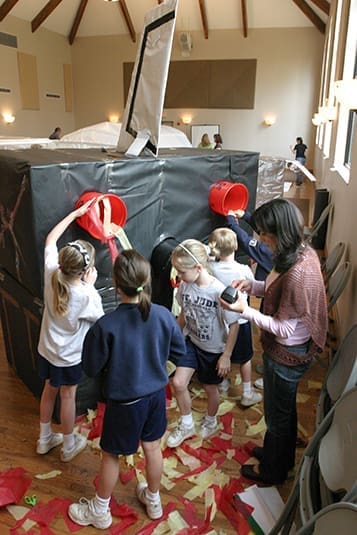U.S. Space and Rocket Center education specialist Melissa Snider, left, ushers in a group of St. Jude School third-graders as they prepare to do additional work on a mock space station and make the solar panels. The USSRC is a NASA center for the public. Photo by Michael Alexander
Atlanta
‘Shuttle’ Sends St. Jude Students Into Orbit
By STEPHEN O’KANE, Staff Writer | Published March 5, 2009
The ministries building at St. Jude the Apostle School was transformed into the abyss of space as students participated in NASA Space Camp’s “Build-A-Shuttle” program the week of Feb. 9.
Students from all grades participated in the program, which brings together teachers, parents, students and representatives of NASA’s U.S. Space and Rocket Center to build a mock space station and shuttle and complete a mock space mission.
Principal Patty Childs said Hope Long, a member of the Parent Teacher Association, brought her the idea. The program, out of Huntsville, Ala., offers students hands-on experience learning about shuttle missions, but also gives them experience solving problems and working as a group.
The program began in the classroom a week prior to the mission. Students were able to ask questions about the project and learn about shuttle missions before they built their own space exploration vehicle, which was named STS-2009.
Students and parents used sheets of plastic and PVC pipe to construct the front of a space shuttle and the international space station, as well as a docking station to connect the two. Each class created its own unique patch for the front of the shuttle. The students also made flags from countries around the world to position on the outside of the space station.
“We want the children to see a project larger than a class and a place that’s bigger than their desk,” said Melissa Snider, one of the USSRC assistants that came to guide the students. She has been building student shuttles for seven years.

Parent volunteer Susie Hagley, right, works with a group of second-graders as they work on the space shuttle’s main engine. Red and black buckets were used to represent the main engines while crepe paper streamers were used to represent the flames. Photo By Michael Alexander
All the students participated, some set up in the mock international space station, some serving as astronauts and others working as mission control operatives, controlling the action and keeping the viewers—an audience of parents, students and teachers—informed of what was happening.
The mission began with a shuttle launch, which was brought to life by the astronauts as they stomped their feet, imitating the loud, intense noise of a space shuttle liftoff.
The crowd applauded as the first-time space travelers successfully left the school behind for the vast abyss of space. Once settled outside the Earth’s atmosphere, two students put on their space suits and left the shuttle for a spacewalk to a nearby satellite, which they repaired.
The crew of the STS-2009 then docked with the space station and four students brought new food and science experiments aboard as they replaced the workers who had been stationed at the international base for six months.
After a successful repair of a solar panel outside the space station, the crew undocked and returned home to the delight and applause of their classmates and parents.
Lisa Durthaler, who has two young girls at St. Jude, Ashlee and Kayla, found that the program got her daughters excited about learning.
“It has really piqued their interest,” she said. “They have come home every day telling me what they are doing and what they accomplished.”
Childs found that many of the adults were surprised at how well the students worked together and how they eagerly faced problem solving challenges head on.
Durthaler also mentioned that the parents were excited to be involved as well, as many came to help build the shuttle and assist in any way they could. Childs said that more than 50 parents participated in the project.
Overall, there were more than a dozen missions completed in two days, allowing plenty of time for each grade to complete its 30-minute mission.
The Build-A-Shuttle program is one of many educational opportunities that the USSRC offers. Others include the summer space camp program in Huntsville and the Starlab Planetarium program in which a USSRC representative travels to the school to set up a planetarium in a school’s gymnasium or auditorium.
St. Jude the Apostle had previously participated in the planetarium program but this year was a first for Build-A-Shuttle. And for Childs, the parents and the science instructors, the program was a success.
“It’s phenomenal,” said Childs. “They will never look at a space shuttle the same way.”
“They are having a great time and we are having a great time,” said a smiling Snider.